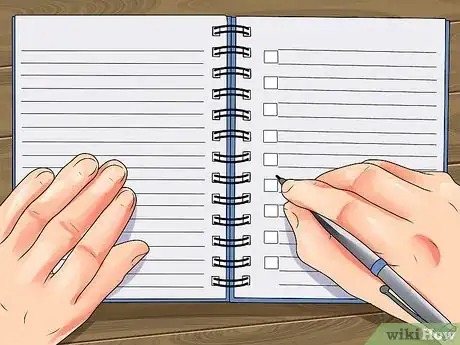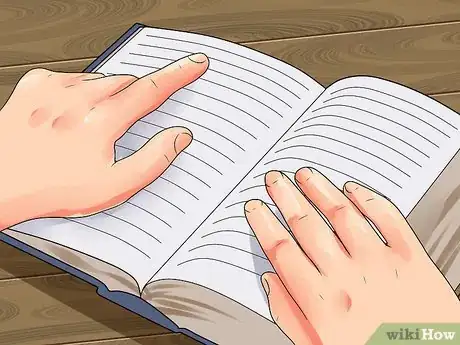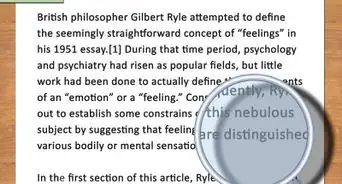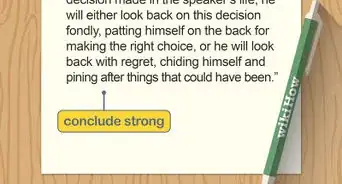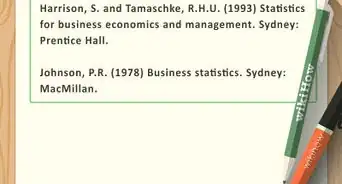This article was co-authored by Christopher Taylor, PhD. Christopher Taylor is an Adjunct Assistant Professor of English at Austin Community College in Texas. He received his PhD in English Literature and Medieval Studies from the University of Texas at Austin in 2014.
There are 13 references cited in this article, which can be found at the bottom of the page.
wikiHow marks an article as reader-approved once it receives enough positive feedback. This article received 66 testimonials and 91% of readers who voted found it helpful, earning it our reader-approved status.
This article has been viewed 1,167,899 times.
Writing a book review is not just about summarizing; it's also an opportunity for you to present a critical discussion of the book so others get an idea of what to expect. Whether you’re writing a review as an assignment or as a publication opportunity, you should combine an accurate, analytical reading with a strong, personal touch. An effective book review describes what is on the page, analyzes how the book tried to achieve its purpose, and expresses any reactions and arguments from a unique perspective.
Steps
Review Template
Preparing to Write Your Review
-
1Read the book and take notes. If possible, read the book multiple times, as repeat reads tend to lead a reader (or reviewer) to view aspects of the story, the setting, and the character(s) in a new or different way.
- Write down notes in a notebook or use a voice recorder to document any thoughts or impressions you have of the book as you are reading. They don't have to be organized or perfect, the idea is to brainstorm any impressions you may have of the book.
- Try summarizing the major sections of the book you’re reviewing to help understand how it’s structured.
-
2Think about the book's genre and/or field of study. Consider how the book fits or does not fit in its genre or field of study. If necessary, use outside sources to familiarize yourself with the field of study and the genre of the book.
- For example, if you are reviewing a non-fiction book about the development of the polio vaccine in the 1950s, consider reading other books that also examine the same scientific issue and/or period of scientific development. Or if you are reviewing a work of fiction like Nathaniel Hawthorne's The Scarlet Letter, consider how Hawthorne's book relates to other 19th-century works of romanticism and historical fiction set in the same time period (the 17th century) as points of comparison.
Advertisement -
3Determine the major arguments and themes of the book. The theme is often a lesson or overall message that the reader perceives between the lines. The theme can also consist of the fundamental and often universal ideas explored in a book. Authors may present multiple themes in their writing, especially works of fiction. These themes will help support the argument that the book is making.
- Pay attention to the preface, any quotes, and /or references in the book's introduction, as this content will likely shed light on the book's major themes and viewpoint.
- A simple way to determine one of the major themes of a book is to sum up the book in one word or sentence.[1] So, for example, the major theme of The Scarlet Letter could be "sin". Once you have your one-word summary, stretch the single word into a message or lesson, such as "sin can lead to knowledge, but it can also lead to suffering."
-
4Consider the author's writing style. Ask yourself if the style suits the book's intended audience. Remember that genre is a category of writing and style is the manner in which a subject is expressed or performed[2] . So, depending on the style used, the author can present different viewpoints to the intended audience.
- For example, in The Scarlet Letter, Hawthorne attempts to combine the writing style of the Romantic Period (1800-1855) with the common, everyday language of the American Puritans of the 1600s. Hawthorne does this with long, descriptive sentences that are strung together with commas and semicolons.[3]
-
5Think about how well the author develops the major areas or points in the book. What areas are covered/not covered? Why? Locating gaps in the timeframe or character development in fiction, or the coverage and analysis in nonfiction can help you think critically. As well, noticing any well-developed elements of the book will help you create good points for your review.
-
6Make note of the book's format, if relevant. Elements like the book's layout, binding, typography, etc. can provide framing and context for the book. If the author provides secondary material like maps, charts, and drawings, always consider how they support or contribute to the book's themes and arguments.
- In the Scarlet Letter, for example, Hawthorne begins the book with an introduction to the text, narrated by an individual who has many autobiographical details in common with the author. In the introduction, the nameless narrator tells the story of finding the manuscript bundled in a scarlet letter "A". Hawthorne uses this narrative framing to create a story within a story, an important detail when discussing the book as a whole.
-
7Consider any literary devices in the book. If the book is a work of fiction, think about how plot structure is developed in the story. Take notes on the book's character, plot, setting, symbols, mood, or tone and how they relate to the overall theme of the book.
- If we were to use the Scarlett Letter again, it would be significant to note that Hawthorne chose the adulterer and sinner Hester Prynne as his protagonist, and placed the religious, anti-sin Reverend Wilson in the role of antagonist. In writing a review of The Scarlet Letter, it would be useful to consider why Hawthorne did this, and how it relates back to the book's overall theme of sin.
-
8Think about how unique the book is. Does it add new information to a genre? The author may be trying to challenge or expand the existing rules and norms of a genre. Consider how the book does this, and how this may affect the intended audience's reception of the book.
-
9Assess how successful the book is. Was the author successful in carrying out the overall purposes of the book, and did you feel satisfied with the book's ending? Would you recommend this book to others?
Creating a First Draft of the Review
-
1Begin with a heading. Most reviews start off with a heading that includes all the bibliographic information about the book. If you haven't been directed on heading format from an editor or professor, use the standard heading of title, author, place of publication: publisher, date of publication, and number of pages.
-
2Write an introduction. A good introduction will grab the reader's attention so they are interested in reading the rest of the review, and will inform the reader what the review will be about.[4]
- Ensure your introduction contains relevant details like the author's background, and if applicable, their previous work in the genre. [5] You can also indicate the main themes you will be discussing in your review to situate the reader and give them an indication of your "take" on the book.
- Several possible openings include: a historical moment, an anecdote, a surprising or intriguing statement, and declarative statements.[6] Regardless of your opening sentences, make sure they directly relate to your critical response to the book and keep them short and to the point.
- If you're unsure on how to begin the review, try writing your introduction last. It may be easier to organize all of your supporting points and your critical position, and then write the introduction last—that way you can be sure that the introduction will match the body of the review.[7]
-
3Write a summary of the book. Once you have established your heading and your introduction, you can then move into a summary of the book's themes and main points.
- Keep the summary short, to the point, and informative. Use quotes or paraphrasing from the book to support your summary.[8] Make sure you properly cite all quotes and paraphrasing in your review to avoid plagiarism.[9]
- Be wary of summaries that begin with phrases like “[This essay] is about…” “[This book] is the story of…” “[This author] writes about…”.[10] Focus on weaving a description of the book's setting, narrative voice, and plot within a critical analysis. Avoid simply regurgitating the book's premise.
- Don't give away important details or reveal the ending of the book in your summary, and don't go into detail about what happens from the middle of the book onwards. [11] As well, if the book is part of a series, you can mention this to potential readers and situate the book within the series. [12]
-
4Evaluate and critique the book. Once you have summarized the book and discussed the main themes and aspects, shift into your critical analysis. This the heart of your review, so be as direct and clear as you can.
- Use the answers you brainstormed during your preparation for the review to formulate your critique. Address how well the book has achieved its goal, how the book compares to other books on the subject, specific points that were not convincing or lacked development, and what personal experiences, if any, you've had related to the subject of the book.
- Always use (properly cited) supporting quotes and passages from the book to back up your critical discussion. This not only reinforces your viewpoint with a trustworthy source, it also gives the reader a sense of the writing style and narrative voice of the book.[13]
- The general rule of thumb is that the first one-half to two-thirds of the review should summarize the author’s main ideas, and at least one-third should evaluate the book.
-
5Wrap up the review. Write a concluding paragraph or several sentences that sum up your critical analysis of the book. If your critical position has been well argued, the conclusion should follow naturally.
- Examine the strengths and weaknesses of the book, and discuss whether you would recommend the book to others. If so, who do you think is the ideal audience for the book?[14] Do not introduce new material in your conclusion or discuss a new idea or impression that was not examined in your introduction and body paragraphs.[15]
- You can also give the book a numerical score, a thumbs up or thumbs down, or a starred rating.[16]
Polishing the Review
-
1Re read and revise your review. Your first stab at a book review may not be as perfect as you'd like, so feel free to revise and adjust your draft. To gain perspective, put the review aside for a few days and then come back to it with fresh eyes.
- Always use spell check and adjust any grammar or spelling. Nothing undermines a quality review more than bad spelling and grammar.
- Double check that all quotes and references are properly cited in your review.
-
2Get feedback. If possible, get someone else to read the review before you submit it to an editor or turn it in to a professor. It is difficult to edit and critique your own work, so ask a friend to read your review and then tell you if they felt the introduction grabbed their attention and if your critical discussion was consistent and developed throughout your review.
-
3Always submit your best work. Make sure you incorporate your revisions and any feedback you have received to create the best final draft. A good review will flow well from introduction to summary to critical analysis, have an interesting perspective on the book, and be free of any grammatical or spelling errors to ensure it is easy to read.
Community Q&A
-
QuestionDo I write the ending in a book review?
 Community AnswerYou should not specifically include the ending of a book in a book review. You can give general impressions about the ending, but actually writing the ending itself is considered a huge spoiler, and will likely turn a lot of people away from your reviews.
Community AnswerYou should not specifically include the ending of a book in a book review. You can give general impressions about the ending, but actually writing the ending itself is considered a huge spoiler, and will likely turn a lot of people away from your reviews. -
QuestionWhat is the most important element in a review?
 Community AnswerThe introduction, as if you have a catchy one, readers will be more interested in reading the review.
Community AnswerThe introduction, as if you have a catchy one, readers will be more interested in reading the review. -
QuestionWhy do you say the introduction is the most important part? I have been told my my teacher that the body is the most important part.
 Community AnswerAll parts are important. Which is the 'most' important depends on the perspective you look at it from. The introduction is important in that it draws in the reader's attention and interest, and makes clear what you're going to be discussing in your paper. The body is important in that it's where most of the real discussion takes place.
Community AnswerAll parts are important. Which is the 'most' important depends on the perspective you look at it from. The introduction is important in that it draws in the reader's attention and interest, and makes clear what you're going to be discussing in your paper. The body is important in that it's where most of the real discussion takes place.
References
- ↑ http://homeworktips.about.com/od/writingabookreport/a/theme.htm
- ↑ http://www.thedramateacher.com/genre-or-style-a-dramatic-problem/
- ↑ http://www.penguin.com/static/pdf/teachersguides/scarletletter.pdf
- ↑ http://grammar.ccc.commnet.edu/grammar/intros.htm
- ↑ http://writingcenter.unc.edu/handouts/book-reviews/
- ↑ http://grammar.ccc.commnet.edu/grammar/intros.htm
- ↑ http://writingcenter.unc.edu/handouts/introductions/
- ↑ https://www.wikihow.com/Write-a-Book-Summary
- ↑ https://writing.wisc.edu/Handbook/QPA_quoting.html
- ↑ http://writingcenter.unc.edu/handouts/summary-using-it-wisely/
- ↑ http://www.booktrust.org.uk/books/teenagers/writing-tips/tips-for-writing-book-reviews/
- ↑ http://www.booktrust.org.uk/books/teenagers/writing-tips/tips-for-writing-book-reviews/
- ↑ http://teacher.scholastic.com/writewit/bookrev/tips.htm
- ↑ http://www.infoplease.com/homework/wsbookreporths.html
- ↑ http://guides.library.queensu.ca/bookreviews/writing
- ↑ http://www.booktrust.org.uk/books/teenagers/writing-tips/tips-for-writing-book-reviews/
- ↑ http://teacher.scholastic.com/writewit/bookrev/tips.htm
- ↑ http://writingcenter.unc.edu/handouts/book-reviews/
About This Article
To write a book review, start with a heading that includes the book's title, author, place of publication, publisher, date of publication, and number of pages. Then, open your review with an introduction that includes the author's background as well as the main points you'll be making. Next, split up the body of your review so the first half of the review is a summary of the author's main ideas and the rest is your critique of the book. Finally, close your review with a concluding paragraph that briefly summarizes your analysis. To learn how to read a book critically so it's easier to write a review, keep reading!






